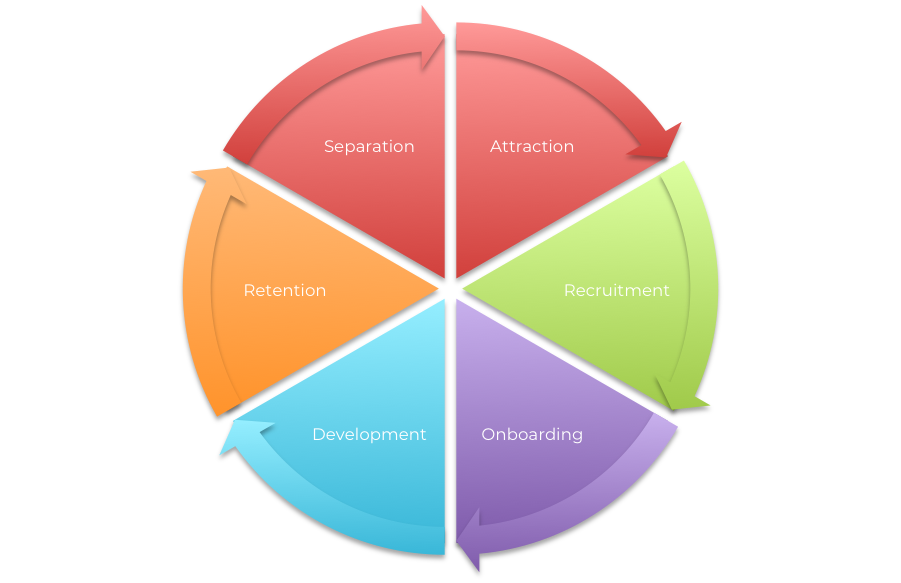
21 Jan Are You Managing Your Employees’ Life Cycle Effectively?
Manage First, Lead Second
It’s 2020 and a new year, and decade has taken flight. Instead of a post about goal setting or motivational maxims for 2020, I’m re-sharing this post from last year on managing the employee life cycle. It’s a reminder that before you can lead (inspire), you’ve got to know how to manage (create clarity). Just ask any employee……
Originally published February 2019
The employee life cycle is a simple way to describe the stages that an employee experiences during their time in a company and has been used in HR for many years. From attraction to separation, each employee experiences these key stages and leaders are the key stewards of the employee experience in each stage.
There’s an entire universe of leadership resources, materials and coaching available to leaders at all levels. In this universe, words like empowerment, effective teams, driving results, passion and vision appear regularly.
While doing my research, I came across Peter Drucker’s familiar quote, “Management is doing things right; leadership is doing the right things”. I agree, the task of doing things right is important! It sets the foundation for a leader to be able to do the right things!
Being skilled at the basics of leading employees can get overlooked and in my experience it often does. As a leader are you effectively doing both? Do you know what stage your employees are currently in and what they need to be successful?
There are 3 main areas the stages of the life cycle fall into:
- Pre-Employment
- Employment
- Post-Employment
At first pass this may seem pretty rudimentary, yet leaders get busy and forget the importance of “doing things right” so that their employees’ work experience is enduring and meaningful.
As a leader are you confident that you are managing your employees in each of these 3 areas effectively? Are you comfortable with what your accountabilities are?
Below is a very high level view of the role of a leader in each of the 3 areas from pre to post employment.
Pre-Employment – Attraction and Recruitment
Before an employee joins a company they engage with the organization via passive and active recruitment activities. As a leader you need to be able to:
- Articulate the company’s brand and values. You want to confidently answer what they are and share what they mean to you with potential hires.
- Clearly articulate the roles, duties and responsibilities required for your team. What is the job and how do you see the employee doing the job to be successful?
- Understand your management style and your own “why” so you can share with potential candidates who may join your team.
During this part of the life cycle, your role is to be an ambassador of your organization and share compelling reasons to join your company. Attracting and securing talented people is a key leadership skill.
Employment – On-Boarding, Development and Retention
After an employee has joined the organization, they are looking for confirmation that they have made the right choice and that they will achieve a return on their investment of time and effort. They want to grow their knowledge and expertise and use their talents to get results. As a leader, your role is to effectively integrate employees into productive teams and the organization. Some key ways to do this are to:
- Understand and address development needs (skill and performance) in a timely way. Have meaningful conversations with employees.
- Know what motivates each of your employees. Provide genuine acknowledgement and recognition.
- Set clear direction and goals so employees know where and how to direct their efforts.
Discovering and growing your employees’ talents and capacity are the keys to retaining them, and creating a fun and productive workplace.
Take time to really understand your employees’ talents and find ways to develop them.
Post-Employment – Separation
At some point in our role as leaders, employees will leave the team and/or the organization. Employee separations can be caused by positive or negative turns of events. It’s the leader who makes the biggest impact on the employee and the reputation of the company when they leave. Regardless of how an employee leaves:
- Ensure dignity and respect of the employee no matter what.
- Create opportunities to capture and transfer knowledge.
- Take time to reflect and understand any learning opportunities, both good and bad to do things better.
As a steward of your employees’ experience, do the right things and take time to do them well. Chris Hadfield, the first Canadian astronaut to walk in space, said it well,
“Ultimately, leadership is not about glorious crowning acts. It’s about keeping your team focused on a goal and motivated to do their best to achieve it…It is about laying the groundwork for others’ success, and then standing back and letting them shine”.
I couldn’t agree more.

No Comments